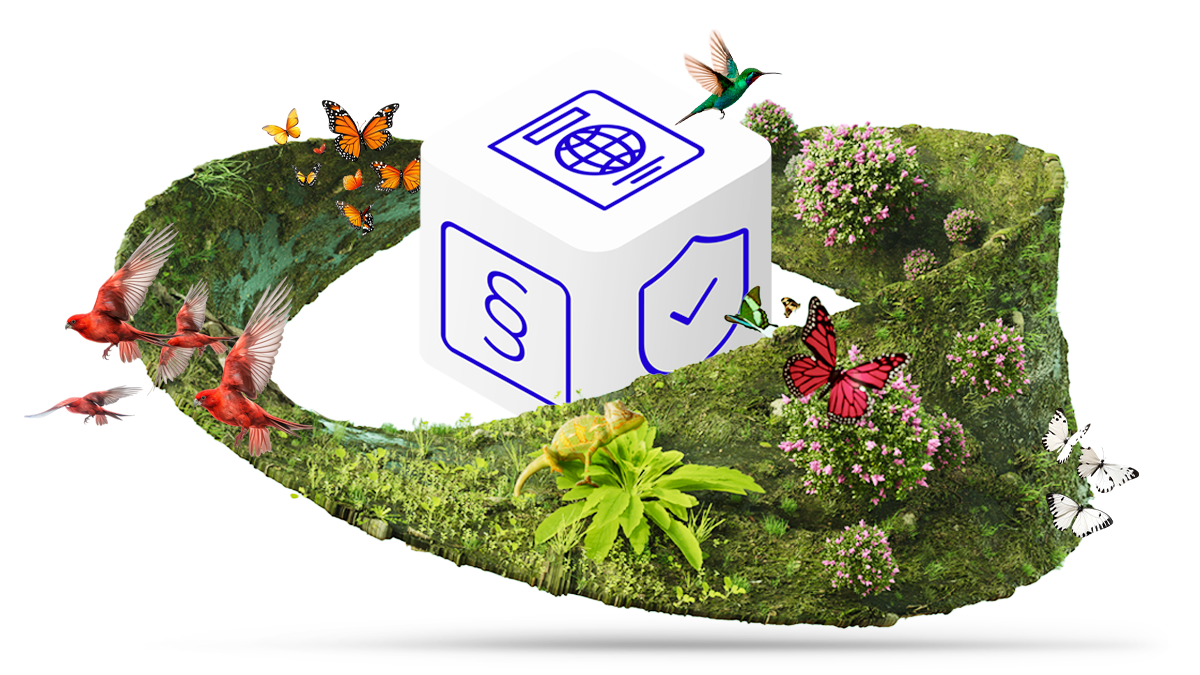E-commerce in 2025: Trends Predicted by Experts

Table of Contents
- Unlocking Business Growth with Composable Commerce
- AI-Powered Retail: Streamlining for Success
- Customer Experience: It's All About the Feeling
- Sustainability: Shopping with a Conscience
- Mobile Shopping: It's Not Just for Cat Videos Anymore
- AI in PIM: Simplifying Complexity and Driving Efficiency
- Key Takeaways
Predicting the future with absolute certainty is impossible, but in business, data provides the best foundation for informed predictions. By analysing trends we can anticipate shifts and prepare for what’s next.
While no forecast is foolproof, experts from Avensia, Iona, Occtoo, Novicell, and Bluestone PIM have shared their insights on what 2025 holds for online retail. Their experience, backed by data, provides a clear vision of the trends set to shape the industry - no crystal ball required ;)
Unlocking Business Growth with Composable Commerce
We're seeing a real shift away from the traditional 'all-in-one' platforms to a much more flexible, modular approach. Retailers are increasingly looking for more flexibility, efficiency and cost effectiveness. Instead of buying huge, expensive platforms crammed with features they may never use, they're now opting for a 'best of breed' strategy. This allows them to cherry-pick the best services for their specific needs and create a truly customised solution that fits their business perfectly.
The way we pay for software is likely to change too. Instead of buying entire commerce platforms with features you might never use, businesses will only pay for the specific services they need. A small merchant might just need microservices for product data and checkout while a larger one might need the full suite with marketplace connections and greater intelligence.
Technology will unlock new types of business models. Contracts are emerging where wholesale prices adjust automatically based on real-time sales data. If a product sells well, the supplier gets a better margin. If it doesn't, they share the risk with the seller. This helps both parties and reduces waste. Systems will be able to handle working capital, adjust payment terms, and manage transactions on their own, making better financial decisions 24/7.
The common thread here is that commerce technology is becoming more dynamic, composable and interconnected. Businesses that adapt to these changes early will have a significant advantage. The future of commerce isn't about big, monolithic systems - it's about nimble, efficient operations that are built for change. - says Mikko Mantila | CEO and Founder at IONA.
AI-Powered Retail: Streamlining for Success
Delivering exceptional customer experiences is no longer just a nice-to-have; it’s a crucial factor for survival. Every interaction - from discovery to delivery and returns - must be seamless.
By leveraging AI across the board - from predicting what customers want to ensure they receive the correct orders - retailers can work smarter, not harder. This translates to better service for customers and stronger businesses overall.
To anticipate future trends in retail, we can look at companies that excel in creating seamless and frictionless customer experiences. For instance, Amazon has made significant investments in areas like product discovery, supply chain optimisation, conversion enhancement, last-mile delivery, and efficient return management. This list is extensive. Achieving success in these areas requires a strong workforce, substantial capital investment, and an innovative mindset - two of which many retailers currently lack due to the prevailing financial climate.
So how can retailers compete without greatly impacting their profits while striving to build genuine and profitable customer loyalty? We are entering an era where AI - encompassing big data, data analytics, and more - can be particularly beneficial. It offers retailers the opportunity to streamline processes across various fields, such as supply chain management, product information management, customer service, personalisation, experimentation, and store operations. By doing so, retailers can redirect their resources more effectively. For example, store associates could be tasked with more complex jobs that require human interaction, ultimately enhancing customer loyalty towards a frictionless shopping experience.
We are already witnessing the growth of AI in areas such as supply chain operations, which include improvements in forecasting, shelf management, promotion and inventory optimisation, and return management. Other areas we will see grow (beyond ideas and paper products) during 2025 include loss prevention, product content onboarding and enrichment, price optimisation, customer service with conversational AI, and enhanced personalised product discovery. - says Johan Liljeros | Chief Strategy Officer, Avensia.
If you need support creating engaging product descriptions, see how much you can save with AI automation.
Discover the cost difference between manual product data enrichment and AI-driven enrichment.
Number of products requiring description
Average Word Count per Product Description
Manual/Human Copywriting Cost per Word
Your Current Cost Estimation:
$ for human copywriting of words to create product descriptions.
You are just one step away from discovering how much you can save with AI in PIM!
The AI calculates costs based on the number of input and output tokens, with each token representing approximately four characters. The cost per token varies depending on the model used.
Basic GPT Model: Less powerful, lower cost, produces simpler or less detailed responses, and might be faster due to smaller size or fewer computations.
Advanced AI Model: More powerful, higher cost, produces higher-quality and more detailed responses, but could be slower because of increased computational complexity.
Pricing for AI models often decreases with each new release, making advanced processing more cost-effective over time.
Bluestone PIM AI Enrich estimation
- With Basic AI model $x.xx
- With advanced AI model $x.xx
Customer Experience: It's All About the Feeling
It's not enough to just sell stuff anymore; you have to make customers feel something. That’s why customer-centricity is the new black.
The businesses that truly thrive today are the ones that put their customers first - not just by selling great products, but by creating real, meaningful experiences. Whether it’s through personalisation, outstanding service, or building a sense of community, brands that genuinely care about their customers stand out from the rest.
Having the ability to build and ship relevant digital customer-centric experiences quickly to the market will definitely be pivotal to the success of online retail.
Companies and brands are creating different touchpoints to interact with customers and collecting precious data needed to build even better campaigns and experiences, so connecting this CX data will be of high significance.
Thus, technologies like Experience Data Platform (XDP), connecting and activating all data and content from any system to build new digital experiences at lightning speed, will become absolutely necessary in creating a successful online retail strategy. - says Jimmy Ekbäck | CTO, Occtoo.
Sustainability: Shopping with a Conscience
Retailers, take note: customers want to know where your products come from, how they're made, and whether your business is ethical. 72% of consumers said they buy more eco-friendly products than five years ago.
This means you need to provide detailed product information, and you can expect a push from new regulations such as the Digital Product Passport introduced under the Ecodesign for Sustainable Products Regulation (ESPR) and set to launch in 2026.
Product Information Management (PIM) systems will be key to supporting sustainability efforts by tracking and organising data on product origin, carbon footprint, and recyclability.
As a consumer, I try to make environmentally friendly and sustainable purchasing decisions as often as possible. I remember when I was looking for a pair of shoes that were sustainably and ethically made. I found the shoes I liked.
However, the online retailer's product descriptions and labels were vague. They contained no information about the materials used, the manufacturing process or the working conditions of the workers who produced the shoes.
As a result, I wasn't sure if the shoes met my sustainability standards and ultimately decided against buying them.
As clients become more aware of the origin and impact of the products they buy, providing detailed, easily accessible product information is no longer an option. This is a chance to not only comply with the new regulations, but also to strengthen your relationship with your customers by demonstrating your commitment to sustainability, ethics and responsible sourcing. The Digital Product Passport is more than just a label - it’s the foundation for trust in a modern, responsible marketplace. - says Borgar Hestad | EVP Sales & Partner Alliance, Bluestone PIM.

Want to learn more about the DPP?
Mobile Shopping: It's Not Just for Cat Videos Anymore
Mobile commerce (m-commerce), which involves purchases made through smartphones and tablets, is expected to become even more dominant. Retailers should optimise their websites for mobile devices, ensuring a smooth user experience, secure mobile payment options (like mobile wallets), and easy checkout processes. This includes leveraging social commerce capabilities on platforms where users are already discovering and researching brands.
Millennials and Gen Z are particularly mobile-first. In 2023, Millennials' app usage climbed to 72%, while Gen Z's surged to 82%, making mobile engagement crucial for reaching these key demographics.
At Novicell, we believe mCommerce will take up more space in the forthcoming years as it continues to become a more popular shopping medium.
Today, customers use social media platforms to identify brands’ values as well as research, discover and purchase on the app. Facebook, Pinterest and Twitter have implemented “buy now” call-to-action buttons that urge users to complete a purchase on the platform.
As consumers become more confident with their mobile devices, they will be even more likely to grab their phones for online shopping.
Especially Millennials and Gen Z’ers are skilled tech savvies who use their phone for everything from mobile banking to electronic ticketing and using virtual marketplace apps such as Amazon. For that reason, mCommerce has a great opportunity of becoming an important sales channel.
So, what can companies do to adjust to this globally rising shopping trend? They must adapt to customers’ new buying behavior if they want to claim their market share.
To accommodate this, an updated website layout for phone devices is essential to ensure a good user experience. Also, providing secure payment options is key, where mobile wallets and contactless credit cards make purchasing even easier.
Optimising one’s business to mobile-friendly use is crucial to keep up with technology growth and meet customers where they are. - says Molly Flaherty | Digital Marketing Executive, Novicell.
AI in PIM: Simplifying Complexity and Driving Efficiency
AI-powered PIM systems are set to play a key role in e-commerce by 2025, with a strong focus on efficiency. A Gartner survey highlights Product Information Management as a top AI use case for high-growth companies.
As companies manage increasing volumes of product data across multiple sales channels, AI-driven features will help automate content creation, enhance personalisation, and improve localisation processes.
By incorporating AI into product information strategies, retailers can reduce manual effort, minimise errors, and maintain consistency in product descriptions across markets. AI can automatically enrich product content, translate and tailor it for different regions, and analyse customer interactions to optimise product listings. This enables businesses to react more swiftly to market trends and evolving consumer preferences.

AI will no longer be an add-on but a
fundamental part of the PIM toolkit.
In 2025, AI assistants and agents
will be used extensively to automate
repetitive PIM processes, such as
data enrichment, translations, quality
checks, and taxonomy management.
AI will empower businesses to
accelerate time-to-market, improve
data consistency, and significantly
reduce manual labor, allowing for
creativity and strategic decision-making.
Morten Naess CTO | Bluestone PIM
Key Takeaways
The future of e-commerce is defined by flexibility, AI-driven efficiency, and customer-focused strategies. Here are the key takeaways from the article:
-
Composable Commerce is gaining traction as businesses move away from "all-in-one" platforms to more flexible, modular approaches, allowing them to select specific services that meet their needs.
-
AI is transforming retail, streamlining operations and enhancing customer experiences. From supply chain management to product information and customer service, AI-driven tools help businesses work smarter and more efficiently.
-
Customer experience is a top priority, with personalisation, excellent service, and community engagement playing a key role in brand success. Technologies like Experience Data Platforms (XDP) will be essential for connecting customer data and delivering seamless digital experiences.
-
Mobile commerce is expected to continue its growth, making it essential for retailers to optimise their websites for mobile devices and provide secure payment options. Millennials and Gen Z are key demographics for mobile engagement.
-
Sustainability matters more than ever, with consumers increasingly demanding transparency about product origins, ethical sourcing, and environmental impact. PIM systems can support these efforts by centralising and tracking sustainability data.
-
AI-powered PIM systems will automate content creation, enhance personalisation, improve localisation, and reduce manual effort in managing product data.
Subscribe to the Newsletter
The future is full of opportunities - we’re here to help!






